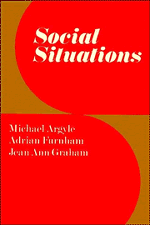Book contents
- Frontmatter
- Contents
- Preface
- 1 Introduction
- 2 The analysis of social situations
- 3 The effect of the situation on behaviour
- 4 Drives and goals
- 5 Rules
- 6 Role-systems
- 7 Repertoire of elements
- 8 Sequences of interaction
- 9 Concepts and cognitive structures
- 10 Environmental setting
- 11 Language and speech
- 12 Stressful situations
- 13 Applications of situational analysis
- 14 Conclusions
- References
- Names index
- Subject index
12 - Stressful situations
Published online by Cambridge University Press: 01 June 2011
- Frontmatter
- Contents
- Preface
- 1 Introduction
- 2 The analysis of social situations
- 3 The effect of the situation on behaviour
- 4 Drives and goals
- 5 Rules
- 6 Role-systems
- 7 Repertoire of elements
- 8 Sequences of interaction
- 9 Concepts and cognitive structures
- 10 Environmental setting
- 11 Language and speech
- 12 Stressful situations
- 13 Applications of situational analysis
- 14 Conclusions
- References
- Names index
- Subject index
Summary
Introduction
Everyone finds some situations difficult or a source of anxiety. Most research relevant to stressful situations has been concerned with anxiety, for example in the form of fear of pain, of social embarrassment or other kinds of subjective distress. On the other hand it may be difficult to deal effectively with certain situations without necessarily experiencing high levels of anxiety. Marshall, Staian and Andrews (1977) found that social skills training improved social competence as rated by observers more than systematic desensitisation did, while systematic desensitisation had more effect on self-reports of anxiety. We shall see below that women report more social anxiety than men but fewer women complain of being socially inadequate. Social inadequacy has sometimes been equated with lack of assertiveness, but we have argued elsewhere that this is only one form of inadequacy (Argyle, 1980b).
Anxiety has been an active area of psychological research since the beginning of the century and has been studied by experimenters of various theoretical persuasions. Some have considered anxiety to be a stable, chronic state measurable in terms of a personality dimension (Cattell, 1950) while others have viewed it as a special reaction to situations in which a person has previously encountered pain (Miller and Dollard, 1945). Still others have viewed anxiety as a state of the person which varies across time and situations (Spielberger, 1966; Endler and Hunt, 1968).
- Type
- Chapter
- Information
- Social Situations , pp. 319 - 357Publisher: Cambridge University PressPrint publication year: 1981



